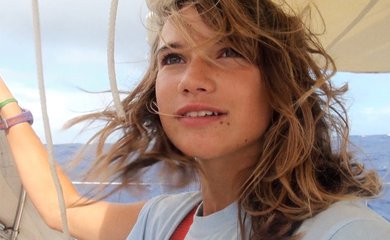While Robert Redford (star of J.C. Chandor’s “All Is Lost”) and Tom Hanks (playing the titular “Captain Phillips” in Paul Greengrass’s latest) are surely setting their compasses in the direction of Oscar right about now, American filmmaker Jillian Schlesinger has found a smaller fish – with an equally tailored-for-Hollywood tale – to fry. Schlesinger’s “Maidentrip,” made in collaboration with her photogenic and charismatic teenage subject, is the real-life story of the remarkable Dutch sailor Laura Dekker, who in January 2012 at age 16, fulfilled her dream to become “the youngest ever to sail around the world alone.” Combining footage shot at Dekker’s stops along the two-year journey with that of the solo sailor’s own video and voice recordings made on her good ketch Guppy, Schlesinger and her all-female team of filmmakers have given us what amounts to a refreshing nonfiction antidote to this season’s seasoned-men-at-sea flicks. Schlesinger spoke with Global Comment prior to the film’s January 17th opening at the IFC Center in NYC.
Lauren Wissot: So how did this filmmaking partnership come about? Can you discuss the genesis of the doc?
Jillian Schlesinger: I read about Laura in the “New York Times” in 2009 when the Dutch government had first intervened to prevent her voyage, and I was instantly captivated. Everyone had an opinion on the topic of whether a person so young should sail around the world, but I never thought about it in those terms. I was interested in Laura as a person, interested in hearing her unique story from her point of view, which seemed all but missing from the conversation in the media. I reached out to her with the idea of a collaborative film project – a first-time adventure for both of us – and she responded. I took a solo bike trip across southern Holland to meet Laura and her dad on the boat where they were living in early summer 2010, about a month before she got permission to do the trip. And together we hatched a plan for making the film.
LW: Since this was a solo trip around the world Laura had to be responsible for all the onboard camerawork. Did a filmmaking team meet her at certain ports to continue documenting? In terms of logistics, how exactly did this work?
JS: Laura had simple equipment on board with her and I met her, sometimes alone and sometimes with a one or two person crew, at various ports around the world. On each trip we would film Laura’s adventures on land, collect the footage from the previous leg, and fix or replace anything that was broken. I would also often nudge Laura about doing her recordings, the unscripted voice diaries that would ultimately become the narration for the film. I was totally hands-off about Laura’s camerawork, never told her how or what or how often to shoot. But the recordings allowed me to suggest topics I was interested in hearing about throughout the trip that would ultimately anchor the emotional journey of the film.
LW: What was the editing like? I assume Laura didn’t keep the camera running everyday, but how many hours were you dealing with and how did you shape the story?
JS: All told, we had about 100 hours. We first focused on the physical journey, and then started weaving in the backstory and more emotional and psychological elements, as well as the animated map sequences. It was great to have Laura in on the process, too. She came and crashed on my couch in New York for a month while we worked on it. She had a voice in that part of the process that I think is unusual for a documentary subject, but I thought it was really important because the film is very subjective and intended to represent only her point of view. Laura wore the hat of filmmaker very well and picked up a lot of our editing lingo in the process.
LW: What was the most difficult aspect of the filmmaking process?
JS: The most difficult part was getting through production on such a serious shoestring budget. We felt the pressure of the story unfolding in real time, but had a hard time raising the money we needed to do things to the level we wanted. We found many ways to cut costs (staying with Laura in ports, soliciting donations of airline miles instead of financial support) and then would occasionally spend a lot on something we felt we couldn’t spare, like the aerial shots featured in the beginning and end of the film. We were fortunate in post to encounter Louis Venezia and his company Pilot, so we didn’t have the same challenges in the edit. Louis and his business partner Rebecca Ritchie-Brower came on as executive producers, and Pilot became a producing partner and essential ally in getting the film finished.
LW: Were there any moments not captured on camera that you wish you’d had access to?
JS: When Laura was in especially bad storms or difficult situations that required her full attention, it simply would not have been safe for her to focus on filming. So I imagine that the scariest, most trying moments of Laura’s voyage are not fully represented in the film. A documentary can never tell the whole story, it tells the story that the camera captured, and in this case the constraint of Laura filming alone at sea dictated what was filmed, and defined the narrative in a really interesting and unique way.

